Quantifying High-Temperature and Drought Stress Effects on Soybean Growth and Yield in the Western Guanzhong Plain
Abstract
:1. Introduction
2. Materials and Methods
2.1. Overview of the Study Area
2.2. Data
2.3. Research Methods
2.3.1. Calculation of Single-Station Comprehensive Intensity of High Temperature and Determination of Intensity Grades
2.3.2. Single-Station Daily High-Temperature Climate Index
2.3.3. Drought Characteristic Extraction
3. Results
3.1. Characteristics of Disaster Weather Processes during the Soybean Growth Period
3.1.1. Spatial–Temporal Variations in Characteristics of High-Temperature Processes
3.1.2. Spatial–Temporal Variations in Characteristics of Drought Processes
3.1.3. Spatial–Temporal Variations in Characteristics of High Temperature Combined with Drought Processes
3.2. Impact Analysis
3.2.1. Impact Analysis of High Temperature
3.2.2. Impact Analysis of Drought
3.2.3. Impact Analysis of High Temperature Combined with Drought
4. Discussion
5. Conclusions
Author Contributions
Funding
Institutional Review Board Statement
Informed Consent Statement
Data Availability Statement
Conflicts of Interest
References
- Jägermeyr, J.; Müller, C.; Ruane, A.C.; Elliott, J.; Balkovic, J.; Castillo, O.; Faye, B.; Foster, I.; Folberth, C.; Franke, J.A.; et al. Climate impacts on global agriculture emerge earlier in new generation of climate and crop models. Nat. Food 2021, 2, 873–885. [Google Scholar] [CrossRef]
- Kern, A.; Barcza, Z.; Marjanović, H.; Árendás, T.; Fodor, N.; Bónis, P.; Bognár, P.; Lichtenberger, J. Statistical modelling of crop yield in Central Europe using climate data and remote sensing vegetation indices. Agric. For. Meteorol. 2018, 260, 300–320. [Google Scholar] [CrossRef]
- Cai, Y.; Guan, K.; Lobell, D.; Potgieter, A.B.; Wang, S.; Peng, J.; Xu, T.; Asseng, S.; Zhang, A.; You, L.; et al. Integrating satellite and climate data to predict wheat yield in Australia using machine learning approaches. Agric. For. Meteorol. 2019, 274, 144–159. [Google Scholar] [CrossRef]
- dos Santos, C.A.C.; Neale, C.M.U.; Mekonnen, M.M.; Gonalves, I.Z.; de Oliveira, G.; Ruiz-Alvarez, O.; Safa, B.; Rowe, C.M. Trends of extreme air temperature and precipitation and their impact on corn and soybean yields in Nebraska, USA. Theor. Appl. Climatol. 2022, 147, 1379–1399. [Google Scholar] [CrossRef]
- Xu, C.; Xia, C.; Xia, Z.; Zhou, X.; Huang, J.; Huang, Z.; Liu, Y.; Jiang, Y.; Casteel, S.; Zhang, C. Physiological and transcriptomic responses of reproductive stage soybean to drought stress. Plant Cell Rep. 2018, 37, 1611–1624. [Google Scholar] [CrossRef] [PubMed]
- Sun, X.; Liu, M.J.; Yang, M.Y.; Lu, J.; Du, J.B.; Shu, K.; Wang, X.C.; Yang, W.Y. Implications of terminal oxidases in the regulation of soybean photosynthetic performance under different lightintensities. Acta Physiol. Plant. 2017, 39, 266. [Google Scholar] [CrossRef]
- Tian, Z.H.; Chen, X.Z.; Xie, H.; Qing, Q. The initial study of the relationship between meteorological factors and agronomic characters of soybean in Beijing area. Chin. J. Eco-Agric. 2003, 11, 15–17. [Google Scholar]
- Ding, Z.L. Effects of climate factors on qualilty of soybean. Acta Agron. Sin. 1965, 4, 313–320. [Google Scholar]
- Quansah, J.E.; Welikhe, P.; El Afandi, G.; Fall, S.; Mortley, D.; Ankumah, R. CROPGRO-Soybean Model Calibration and Assessment of Soybean Yield Responses to Climate Change. Am. J. Clim. Chang. 2020, 9, 297–316. [Google Scholar] [CrossRef]
- Mo, K.C.; Lettenmaier, D.P. Heat wave flash droughts in decline. Geophys. Res. Lett. 2015, 42, 2823–2829. [Google Scholar] [CrossRef]
- Otkin, J.A.; Svoboda, M.; Hunt, E.D.; Ford, T.W.; Anderson, M.C.; Hain, C.; Basara, J.B. Flash droughts: A review and assessment of the challenges imposed by rapid-onset droughts in the United States. Bull. Am. Meteorol. Soc. 2018, 99, 911–919. [Google Scholar] [CrossRef]
- Wang, J.X.; Yang, M.X.; Deng, D.S. The cause of soybean over-green growth and useless pods and the way of prevention. J. Henan Agric. Sci. 1982, 9, 20. [Google Scholar]
- Zhang, S.J.; Hou, L.X. Study on the cause mechanism for pods without peas in soybean under drought stress. Acta Agric. Boreali-Sin. 2005, 20, 61–63. [Google Scholar]
- Xiao, J.H.; Wei, L.; Liu, B.; Duan, X.Y.; Yang, H.F. Analysis on the cause of greenness symptoms phenomenon of summer soybean in Southern Shanxi. J. Shanxi Agric. Sci. 2020, 48, 1305–1308, 1312. [Google Scholar]
- Li, Y.Q.; Wang, Y.X. Causes and countermeasures for reluctant ripen and few pods of soybean in Wuyang County in 2010. Mod. Agric. Sci. Technol. 2012, 1, 117–118. [Google Scholar]
- Lei, Q.K.; Guo, J.Q.; Yang, X.L.; Ma, W. The causes and precautions of summer soybean pods without peas in western Henan. Shaanxi J. Agric. Sci. 2010, 2, 103–116. [Google Scholar]
- Li, W.; Gao, Y.; Hu, Y.; Chen, J.; Zhang, J.; Shi, S. Field Cage Assessment of Feeding Damage by Riptortus pedestris on Soybeans in China. Insects 2021, 12, 255. [Google Scholar] [CrossRef]
- Li, Y.P.; Gu, S. Causes and countermeasures of pod and no seed in soybean. Prim. Agric. Technol. Ext. 2015, 11, 80–81. [Google Scholar]
- Yin, S.P.; Zhu, H.X.; Zhao, H.Y.; Sun, A.H.; Gong, L.J.; Li, B.C.; Li, X.F.; Jiang, L.X. Breeding traits and yield factors of soybean:Response to soil with different drought grades. Chin. Agric. Sci. Bull. 2020, 36, 111–117. [Google Scholar]
- Zhang, H.M.; Liu, J.P.; Lu, X.P.; Zhang, X.J. Incidence and preventive measures of summer soybean staygreen syndrome in Luoyang, Henan in 2018. China Plant Prot. 2019, 39, 57–59. [Google Scholar]
- Mo, X.S.; Liang, J.M.; Li, D.X.; Liang, F.X.; Zhang, M.J.; Liu, M.J.; Xiao, J.P.; Zhang, P. Exploring the Causes and Precautions of Soybean Staygreen Syndrome in Huang-Huai-Hai Regions. Soybean Sci. 2019, 38, 770–778. [Google Scholar]
- Wang, D.G.; Yu, G.Y.; Chen, S.N.; Li, J.K.; Wu, Q.; Hu, G.Y.; Huang, Z.P. Research Progress on Comprehensive Hazard Factors of Soybean Staygreen Syndrome. Soybean Sci. 2021, 40, 708–714. [Google Scholar]
- Liu, L.J.; Lin, H.; Tang, X.F.; Pu, G.F. Drought Stress Influence Soybean Yield Morphogenesis in Different Growth Stages. Soybean Sci. 2011, 30, 405–412. [Google Scholar]
- Guo, S.J.; Yang, K.M.; Huo, J.; Zhou, Y.H.; Wang, G.P.; Li, G.Q. Influence of drought on leaf photosynthetic capacity and root growth of soybeans at grain filling stage. Chin. J. Appl. Ecol. 2015, 26, 1419–1425. [Google Scholar]
- Wang, B.Q.; Zhang, L.F.; Ci, D.W.; Li, W.; Xu, R. Multiple Regresion and Path Analysis between Agronomic Traits and Yield of Summer Sowing Soybean (Glycine max L. Merr.) in Huanghuai River Region. Soybean Sci. 2010, 29, 255–259. [Google Scholar]
- Qu, Y.; Wang, K.Z.; Liu, Y.; Kang, J.K.; Liu, Y.B.; Liang, F.Q. Soybean Yield in the Western Guan-Zhong Areas: The Response to Climatic Ecological Condition. J. Agric. 2020, 10, 71–76. [Google Scholar]
- Qu, Y.; Ma, W.; Wang, K.Z.; Zhu, F.; Zhang, H.F.; Yang, H.; Liang, F.Q. Effects of Sowing Date on Agronomic Traits, Yield, and Quality of Soybean in the Western Area of Guanzhong. Soybean Sci. 2022, 41, 696–702. [Google Scholar]
- QX/T 228-2014; Classification of Regional High Temperature Weather Process. 1st ed. China Meteorological Press: Beijing, China, 2015.
- QX/T 597-2021; Monitoring and Evaluation Methods for Regional Drought Processes. 1st ed. China Meteorological Press: Beijing, China, 2021.
- Liao, Y.M.; Zhang, C.J. Spatio-Temporal Distribution Characteristics and Disaster Change of Drought in China Based on Meteorological Drought Composite Index. Meteorol. Mon. 2017, 43, 1402–1409. [Google Scholar]
- Li, M.; Guo, J.; He, J.; Xu, C.; Li, J.; Mi, C.; Tao, S. Possible impact of climate change on apple yield in Northwest China. Theor. Appl. Climatol. 2020, 139, 191–203. [Google Scholar] [CrossRef]
- Shen, Y.C.; Li, S.S.; Yan, J.P.; Wu, Y.Q.; Wang, C.B. Spatiotemporal climate variation and its influencing factors in Shaanxi Province based on extreme-point symmetric mode decomposition. Arid Land Geogr. 2021, 44, 36–46. [Google Scholar]
- Liu, J.J. Analysis of spatiotemporal characteristics of precipitation in the summer and autumn seasons of Shaanxi during the El Ni ñ o year. Agric. Mach. Agron. 2021, 1, 82–84. [Google Scholar]
- Eulenstein, F.; Lana, M.; Schlindwein, S.; Sheudzhen, A.; Tauschke, M.; Behrend, A.; Guevara, E.; Meira, S. Trends of soybean yields under climate change scenarios. Horticulturae 2016, 3, 10. [Google Scholar] [CrossRef]
- Guo, S.; Guo, E.; Zhang, Z.; Dong, M.; Wang, X.; Fu, Z.; Guan, K.; Zhang, W.; Zhang, W.; Zhao, J.; et al. Impacts of mean climate and extreme climate indices on soybean yield and yield components in Northeast China. Sci. Total Environ. 2022, 838, 156284. [Google Scholar] [CrossRef]
- Guo, S.; Yang, X.; Zhang, Z.; Zhang, F.; Liu, T. Spatial distribution and temporal trend characteristics of agroclimatic resources and extreme climate events during the soybean growing season in Northeast China from 1981 to 2017. J. Meteorol. Res. 2021, 34, 1309–1323. [Google Scholar] [CrossRef]
- Li, S.; You, S.; Song, Z.; Zhang, L. Impacts of climate and environmental change on bean cultivation in China. Atmosphere 2021, 12, 1591. [Google Scholar] [CrossRef]
- Wang, C.; Linderholm, H.W.; Song, Y.; Wang, F.; Liu, Y.; Tian, J.; Xu, J.; Song, Y.; Ren, G. Impacts of drought on maize and soybean production in Northeast China during the past five decades. Int. J. Environ. Res. Public Health 2020, 17, 2459. [Google Scholar] [CrossRef]
- Xu, Y.; Chou, J.; Yang, F.; Sun, M.; Zhao, W.; Li, J. Assessing the sensitivity of main crop yields to climate change impacts in China. Atmosphere 2021, 12, 172. [Google Scholar] [CrossRef]
- Li, Q.C.; Xu, S.W.; Zhuang, J.Y.; Liu, J.J.; Zhou, Y.; Zhang, Z.X. Ensemble learning prediction of soybean yields in China based on meteorological data. J. Integr. Agric. 2023, 22, 1909–1927. [Google Scholar] [CrossRef]
- Wang, H.Z.; Tang, H.Y.; Niu, D.; Lv, M. Study on Meteorological Forecasting Method of Key Quality Components in Soybean. Soybean Sci. 2021, 40, 112–121. [Google Scholar]
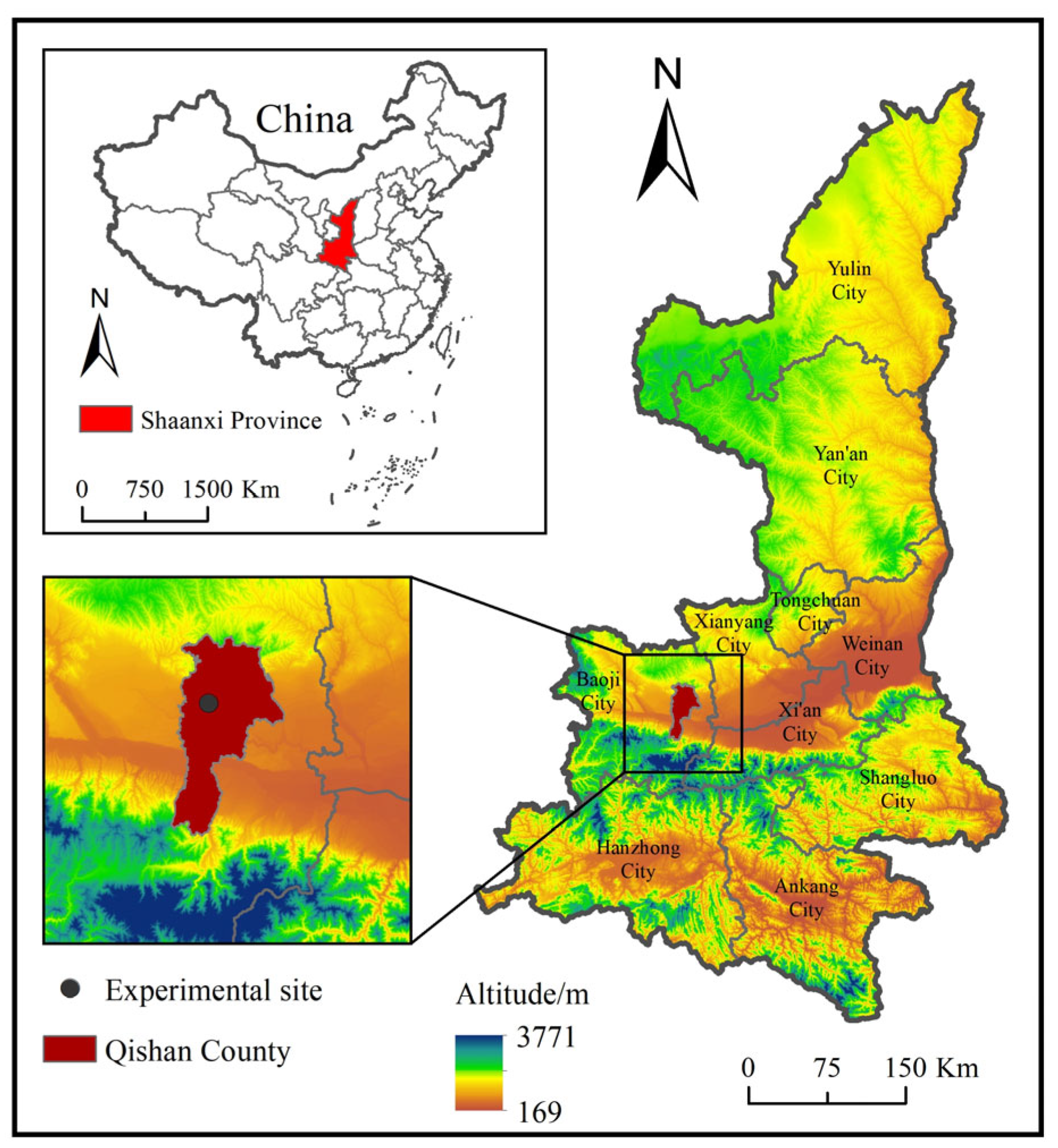

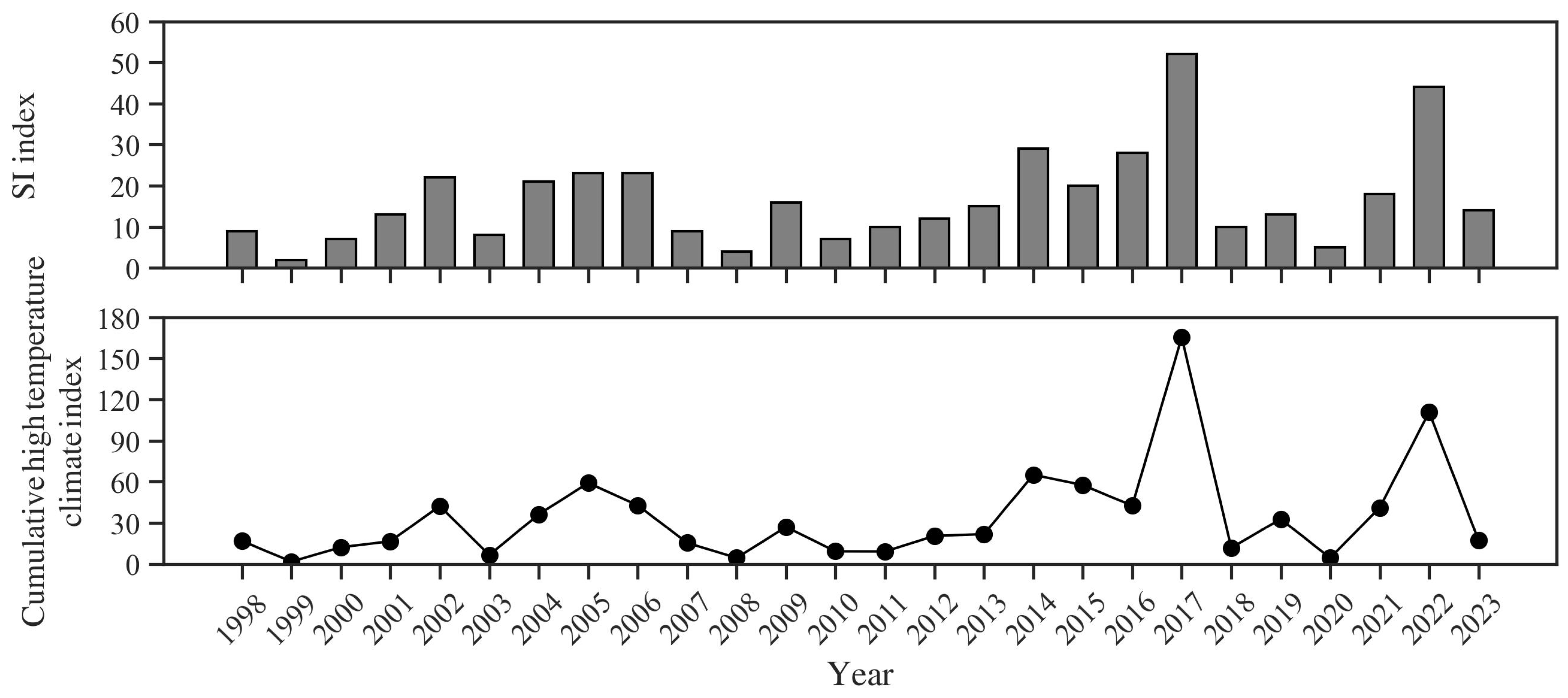
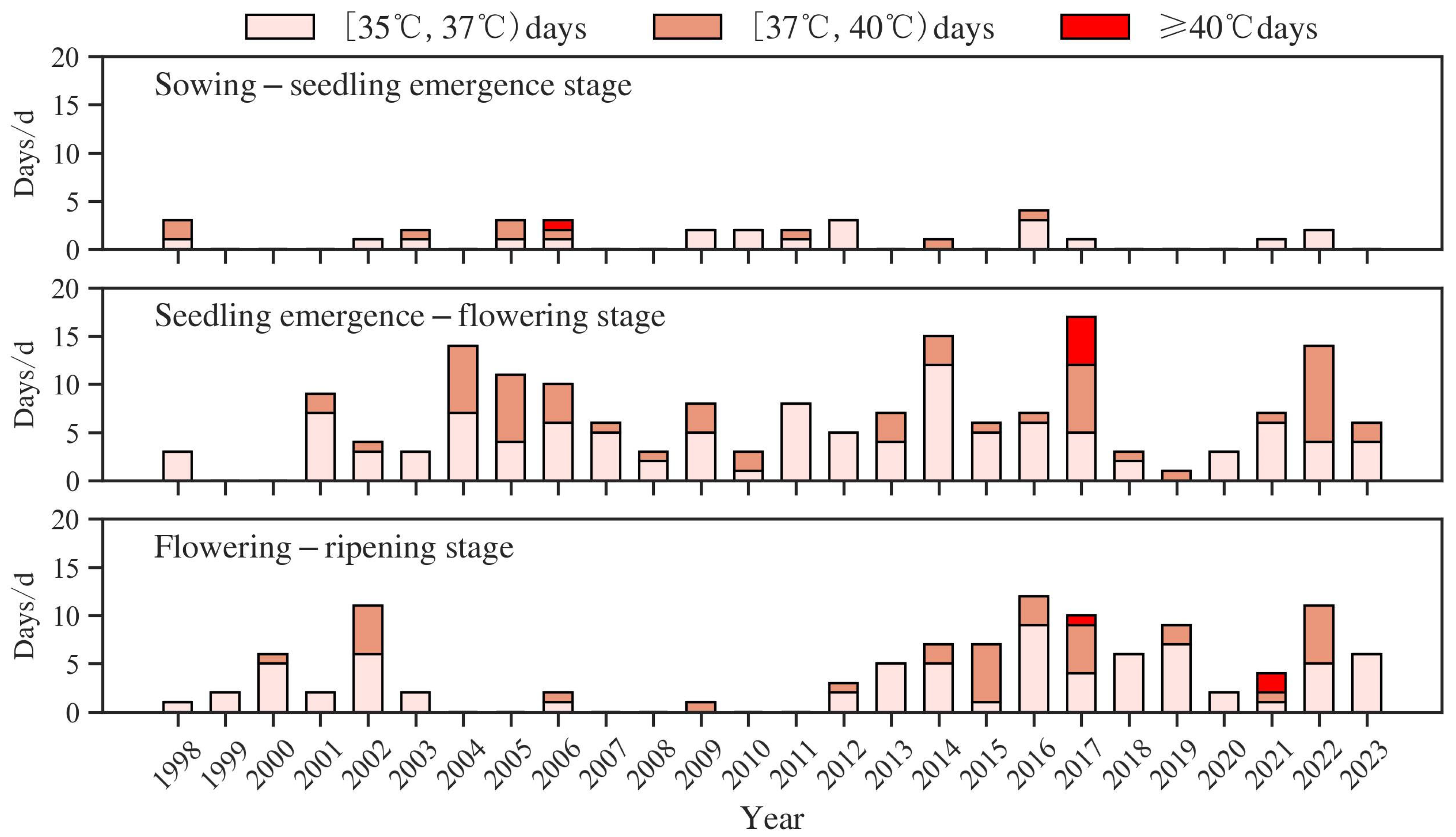
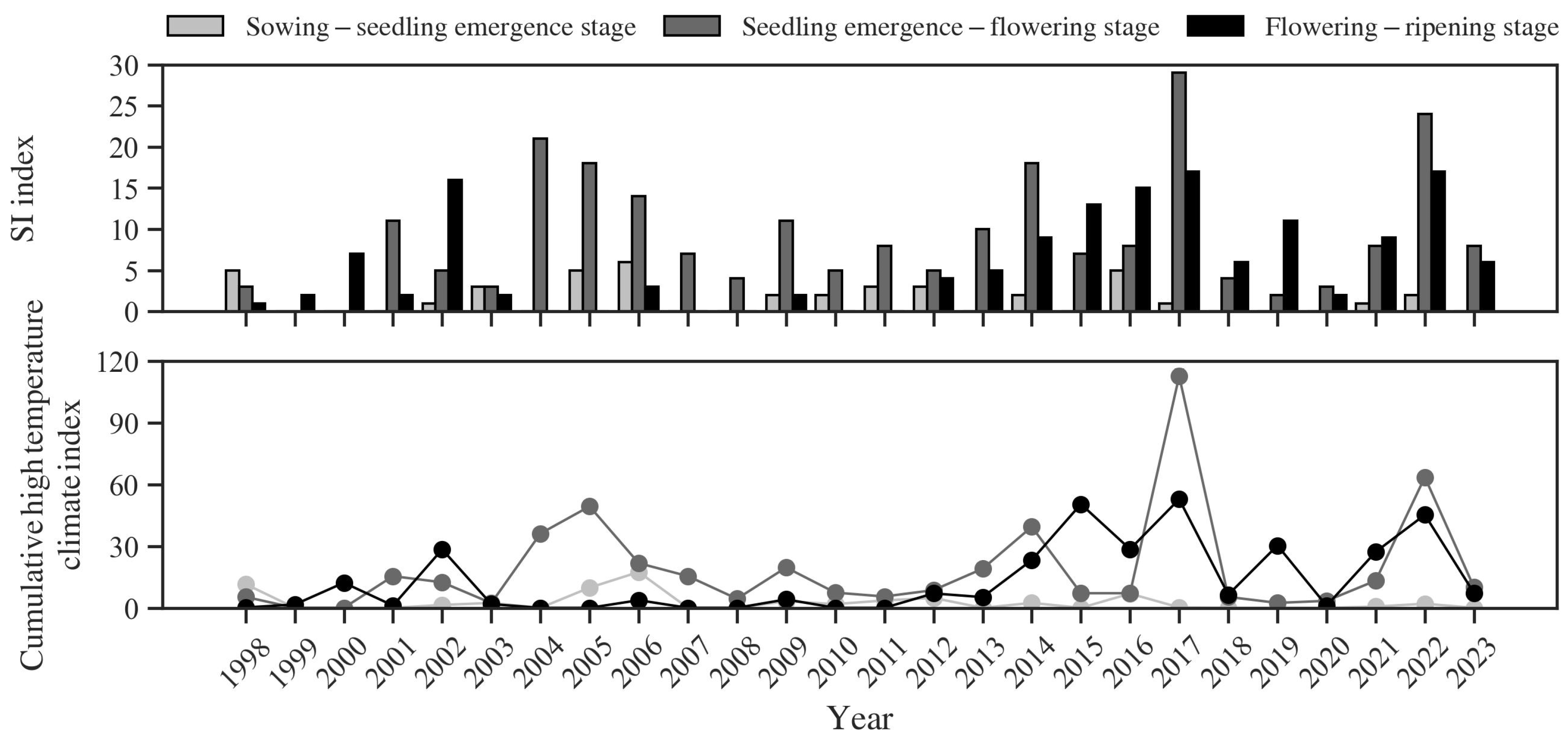
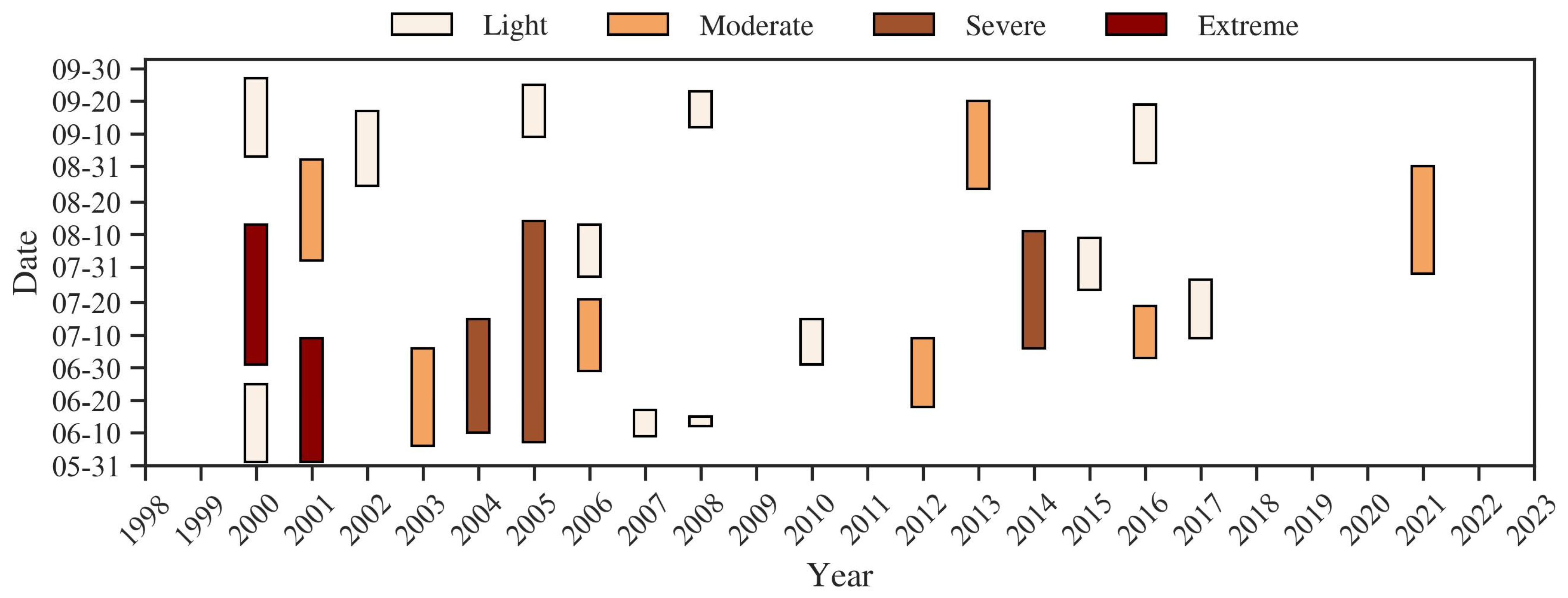
| Gk | Value Conditions |
|---|---|
| Gk = 1 | More than 95% percentiles |
| Gk = 2 | [85%, 95%) |
| Gk = 3 | [60%, 85%) |
| Gk = 4 | Below 60% |
| Gk = 5 | Without high temperature |
Disclaimer/Publisher’s Note: The statements, opinions and data contained in all publications are solely those of the individual author(s) and contributor(s) and not of MDPI and/or the editor(s). MDPI and/or the editor(s) disclaim responsibility for any injury to people or property resulting from any ideas, methods, instructions or products referred to in the content. |
© 2024 by the authors. Licensee MDPI, Basel, Switzerland. This article is an open access article distributed under the terms and conditions of the Creative Commons Attribution (CC BY) license (https://creativecommons.org/licenses/by/4.0/).
Share and Cite
Li, M.; Liu, Y.; Pan, Y.; Zhang, X.; Xu, K.; Qu, Y.; Li, H. Quantifying High-Temperature and Drought Stress Effects on Soybean Growth and Yield in the Western Guanzhong Plain. Atmosphere 2024, 15, 392. https://doi.org/10.3390/atmos15040392
Li M, Liu Y, Pan Y, Zhang X, Xu K, Qu Y, Li H. Quantifying High-Temperature and Drought Stress Effects on Soybean Growth and Yield in the Western Guanzhong Plain. Atmosphere. 2024; 15(4):392. https://doi.org/10.3390/atmos15040392
Chicago/Turabian StyleLi, Meirong, Yuefeng Liu, Yuying Pan, Xuting Zhang, Kemeng Xu, Yang Qu, and Hongmei Li. 2024. "Quantifying High-Temperature and Drought Stress Effects on Soybean Growth and Yield in the Western Guanzhong Plain" Atmosphere 15, no. 4: 392. https://doi.org/10.3390/atmos15040392




